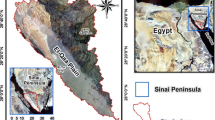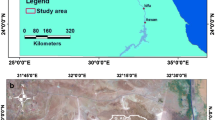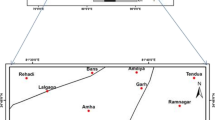Abstract
The Darb el-Arbain study area is in the southern Western Desert of Egypt and has been attracting increasing developmental interest in the last few decades, especially since agricultural development of the southern Baris area, where the groundwater resources of the Nubian Sandstone Aquifer System (NSAS) have been utilized for the cultivation of valuable lands. Due to the proven high potential of both groundwater and land resources, determining the priority areas for sustainable hydrogeological development becomes a necessity. A geographic information system, as a platform for geospatial modeling techniques, has been built, which depends on the recently collected data about the NSAS, in addition to the published databases. Certain criteria of practical value, like depth to groundwater, hydraulic conductivity, groundwater salinity, sodium adsorption ratio, and the safe yield of wells, were selected as decisive parameters for hydrogeological prioritization. The model pinpoints areas characterized by favorable hydrogeological conditions, which could be used for future development and implementation of an artificial storage and recovery (ASR) program. The designated priority areas for hydrogeological development occur at the southern, middle southern and some localized northern parts of the Darb el-Arbain area. The newly formed Tushka Lakes represent a suitable and excellent natural source of freshwater for implementing an ASR program.
Résumé
La zone d’étude Darb el-Arbain, localisée dans le désert Sud-Ouest égyptien, a été l’objet d’un intérêt croissant durant les toutes dernières décades, particulièrement dans le domaine du développement agricole de la région de Baris Sud, où les ressources en eau du Système Aquifère du Grès Nubien (NSAS) ont rendu cultivables des bonnes terres. En raison des potentiels élevés prouvés d’une part de la nappe, d’autre part des terres agricoles, la délimitation de zones prioritaires pour un développement hydrogéologique durable devenait une nécessité. Un système d’information géographique constitué d’une plate-forme de modélisation spatiale a été élaboré, dépendant de bases de données publiées, augmentées de données sur le NSAS réunies récemment. Certains critères d’importance pratique tels profondeur de nappe, conductivité hydraulique, salinité, ratio d’adsorption du sodium, débit critique des puits, ont été sélectionnés comme paramètres décisifs de priorités hydrogéologiques. Le modèle localise des zones présentant un contexte hydrogéologique favorable, où pourrait être développé et réalisé un futur programme de réserve artificielle et de recharge (ASR). Les zones considérées comme prioritaires pour un développement hydrogéologique se trouvent au Sud, Centre-Sud, quelques unes au Nord de la zone Darb el-Arbain. Les Tushka Lakes récemment formés constituent une excellente ressource en eau douce convenant parfaitement à la mise en place d’un programme ASR.
Resumen
El área de estudio de Darb el-Arbain está en sur del Western Desert de Egipto y ha estado atrayendo un creciente interés de desarrollo en las últimas pocas décadas, especialmente desde que el desarrollo agrícola del área sur de Baris, debido a las utilización de los recursos de aguas subterráneas del sistema acuífero de las areniscas Nubian (NSAS) convirtió tierras valiosas en cultivables. Debido al demostrado alto potencial de las aguas subterráneas y de los recursos del suelo, la determinación de áreas prioritarias para un desarrollo hidrogeológico sustentable se convierte en una necesidad. Se ha desarrollado un sistema de información geográfica, como una plataforma para las técnicas de modelado geoespacial, la cual depende de los datos recientemente colectados acerca de NSAS, adicionalmente a las bases de datos publicadas. Se seleccionaron ciertos criterios de valores prácticos, como profundidad del agua subterránea, conductividad hidráulica, salinidad del agua subterránea, relación de absorción de sodio, y el rendimiento seguro de los pozos, como parámetros decisivos para la priorización hidrogeológica. El modelo identifica áreas caracterizadas por condiciones hidrogeológicas favorables, las cuales podrían ser usadas para el desarrollo futuro y la implementación de un programa de recuperación y almacenamiento artificial (ASR). Las áreas prioritarias diseñadas para el desarrollo hidrogeológico se sitúan en el sur, centro sur y algunas partes localizadas en el norte del área de Darb el-Arbain. Los recientemente construidos Tushka Lakes representan una fuente natural de agua dulce adecuada y excelente para implementar un programa ASR.
摘要
Darb el-Arbain研究区位于埃及西部沙漠的南部。几十年来, 特别是对Baris地区南部进行农业开发以来 (因为该地Nubian砂岩含水层系统 (NSAS) 地下水资源的利用造就了适合农业耕作宝贵的土地资源) , 人们开发该地区的兴趣与日俱增。由于已证实该区地下水和土地资源都具有良好的开发潜力, 需要为水文地质可持续开发确定优先开发区域。基于已发表的数据库和近期搜集的NSAS数据, 建立了一个作为地质空间模拟技术平台的地理信息系统。根据实际需要制定了遴选标准, 选择地下水水位、渗透系数、地下水盐度, 钠吸附比和井的安全出水量, 做为水文地质优先性的参数。模型可对具有有利水文地质条件、将来可进行开发及实施人工蓄水和恢复项目 (ASR) 的区域进行精确定位。确定的水文地质优先开发区域位于Darb el-Arbain地区的南部、中南部及北部的局部地区。新形成的Tushka湖是实施ASR项目的一个非常合适的淡水自然源区。
Resumo
A área de estudo, Darb el-Arbain, localiza-se no sul do Deserto Ocidental do Egipto, e vem atraindo um crescente interesse no desenvolvimento nas últimas décadas, especialmente desde o desenvolvimento agrícola da região sul de Baris, onde os recursos de água subterrânea do Sistema Aquífero Arenítico da Núbia (NSAS ) têm sido utilizados, valorizando a terra disponível para cultivo. Devido ao comprovado alto potencial de ambos os recursos, águas subterrâneas e solo, tornou-se necessário a determinação das áreas prioritárias para o desenvolvimento sustentável a nível hidrogeológico. Um sistema de informação geográfica, como uma plataforma para técnicas de modelação geoespacial, foi construído, o qual depende, para além dos dados coligidos recentemente sobre o NSAS, dos dados publicados em bases de dados. Alguns critérios de valor prático, como o nível freático das águas subterrâneas, a condutividade hidráulica, a salinidade da água subterrânea, a taxa de adsorção de sódio (SAR) e a exploração sustentável das captações, foram seleccionados como parâmetros decisivos para a priorização hidrogeológica. O modelo aponta áreas caracterizadas por condições hidrogeológicas favoráveis, as quais poderiam ser usadas para o futuro desenvolvimento e implementação de um programa de armazenamento artificial e recuperação (ASR). As áreas designadas como prioritárias para o desenvolvimento hidrogeológico ocorrem no sul, no centro sul e em algumas regiões localizadas no norte de Darb el-Arbain. Os recém-formados Lagos Tushka representam uma adequada e excelente fonte natural de água doce para implementar um programa de ASR (armazenamento artificial e recuperação).










Similar content being viewed by others
References
Burrough PA, Frank AU (1995) Concepts and paradigms in spatial information systems: are current geographical information systems truly generic? Int J Geogr Inf Sys 9(2):101–116
CONOCO (Continental Oil Company) (1987) Geological map of Egypt (scale 1: 500,000). Conoco Inc. in collaboration with Freie Universitat Berlin
CONOCO (Continental Oil Company) (1989) Geological map of Egypt (scale 1: 500,000). Conoco Inc. in collaboration with Freie Universitat Berlin
Cooper HH Jr, Jacob CE (1946) A generalized graphical method for evaluating formation constants and summarizing well field history. Trans Am Geophys Union 27:526–534
Dillon P, Pavelic P, Sibenaler X, Gerges N, Clark R (1997) Storing storm water runoff in aquifers. Aust Water Wastewater Assoc J Water 24(4):7–11
Dillon P, Toze S, Pavelic P, Skjemstad J, Davis G, Miller R, Correll R, Kookana R, Ying GG, Herczeg A, Fildebrandt S, Banning N, Gordon C, Wall K, Nicholson B, Vanderzalm J, Le Gal La Salle C, Gibert M, Ingrand V, Guinamant J-L, Stuyfzand P, Prommer H, Greskowiak J, Swift R, Hayes M, O’Hara G, Mee B, Johnson I (2005) Water quality improvements during aquifer storage and recovery, vol 1: water quality improvement processes. Final report, AWWARF project 2618, AWWARF, Denver, CO
Driscoll FG et al (1986) Groundwater and wells. Johnson, St. Paul, MN, 1089 pp
Elewa HH (2006) Water resources and geomorphological characteristics of Tushka and West of Lake Nasser, Egypt. Hydrogeol J 14:942–954
ESRI (2007) ArcGIS 9.x Software and user manual. Environmental Systems Research Institute, Redlands, CA. http://www.esri.com. Cited January 2009
Fathy RG (2003) Contributions the subsurface geologic structural pattern of South El-Shab area, South Western Desert, Egypt. J Appl Geophys Soc Egypt 2:53–61
Fathy RG (2004) Contributions to the subsurface geologic structural pattern of the northern and the middle parts of Darb El-Arbeain area, South Western Desert, Egypt. J Appl Geophys Soc Egypt 3:61–75
Fathy RG, EL-Hefnawy M, Abd EL-Hamid A (2001) Contributions to the hydrogeological aspects of the groundwater aquifers in southern part of Darb EL-Arbeain area, southern portion of Western Desert, Egypt. Al-Azhar Bull Sci 12(2):175–194
Fathy RG, EL NM, Atef AA, El-Gammal NM (2002) Contributions to the hydrogeological and hydrochemical characteristics of Nubia Sandstone aquifer in Darb Al-Arbeain, South Western Desert, Egypt. Al-Azhar Bull Sci 13(2):69–100
Ghoubashi SY (2004) Comparative hydrological studies of the Nubia Sandstone aquifer system in East El-Oweinat and Bir El Shab areas, South Western Desert, Egypt. PhD Thesis, Al-Azhar Univ., Egypt, 187 pp
Heinl M, Thorweihe U (1993) Groundwater resources and management in SW-Egypt. In: Meissner B, Wycisk P (eds) Geopotential and ecology-analysis of a desert region. Catena Supplement 26, Catena, Cremlingen, Germany, 199 pp
Issawi B (1978) New findings on the geology of Uweinat, Gilf Kebir, Western Desert, Egypt. Ann GSE, Cairo 4:275–293
Klitzsch E, Squyres CH (1990) Paleozoic and Mesozoic geological history of northeastern Africa based upon new interpretation of Nubia strata. Am Assoc Petrol Geol Bull 74:1203–1211
Korany EA, Fathy RG, Nagaty MEl (2002) Contributions to the hydrogeology of Nubia Sandstone aquifer in the middle part of Darb El-Arbeain, south Western Desert, Egypt. J Sedimentol Soc Egypt 10:119–143
Kruseman GP, de Ridder NA et al (1990) Analysis and evaluation of pumping test data. The Netherlands International Institute for Land Reclamation and Improvement, Wageningen, The Netherlands, 377 pp
Lohman SW (1972) Groundwater hydraulics. US Geol Surv Prof Pap 708, 70 pp, 9 plates
Mace RE (1997) Determination of transmissivity from specific capacity data in a karst aquifer. Ground Water 35(5):738–742
Malczewski J (1999) GIS and multicriteria decision analysis. Wiley, New York
Said R (1962) The geology of Egypt. Elsevier, Amsterdam, 377 pp
Said R (1990) The geology of Egypt. Balkema, Rotterdam, The Netherlands, 734 pp
Theis CV (1935) The relation between the lowering of piezometric surface and the rate and duration of discharge of a well using groundwater storage. Trans Am Geophys Union 16:519–524
Theis CV, Brown RH, Myers RR (1963) Estimating the transmissibility of aquifers from the specific capacity of wells: methods of determining permeability, transmissivity, and drawdown. US Geol Surv Water Suppl Pap 1536-I
Acknowledgements
The authors wish to express their deep gratitude to the National Authority for Remote Sensing and Space Sciences for funding the project from which the data for this work was obtained. Thanks also go to the anonymous reviewers for their suggestions and comments regarding the manuscript. Special appreciation goes to Dr. Shemin Ge (Managing Editor) and Sue Duncan (Technical Editorial Advisor) of Hydrogeology Journal for their valuable comments and advice.
Author information
Authors and Affiliations
Corresponding author
Rights and permissions
About this article
Cite this article
Elewa, H.H., Fathy, R.G. & Qaddah, A.A. The contribution of geographic information systems and remote sensing in determining priority areas for hydrogeological development, Darb el-Arbain area, Western Desert, Egypt. Hydrogeol J 18, 1157–1171 (2010). https://doi.org/10.1007/s10040-010-0590-4
Received:
Accepted:
Published:
Issue Date:
DOI: https://doi.org/10.1007/s10040-010-0590-4




